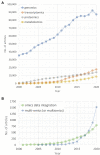Data Management and Modeling in Plant Biology
- PMID: 34539712
- PMCID: PMC8446634
- DOI: 10.3389/fpls.2021.717958
Data Management and Modeling in Plant Biology
Abstract
The study of plant-environment interactions is a multidisciplinary research field. With the emergence of quantitative large-scale and high-throughput techniques, amount and dimensionality of experimental data have strongly increased. Appropriate strategies for data storage, management, and evaluation are needed to make efficient use of experimental findings. Computational approaches of data mining are essential for deriving statistical trends and signatures contained in data matrices. Although, current biology is challenged by high data dimensionality in general, this is particularly true for plant biology. Plants as sessile organisms have to cope with environmental fluctuations. This typically results in strong dynamics of metabolite and protein concentrations which are often challenging to quantify. Summarizing experimental output results in complex data arrays, which need computational statistics and numerical methods for building quantitative models. Experimental findings need to be combined by computational models to gain a mechanistic understanding of plant metabolism. For this, bioinformatics and mathematics need to be combined with experimental setups in physiology, biochemistry, and molecular biology. This review presents and discusses concepts at the interface of experiment and computation, which are likely to shape current and future plant biology. Finally, this interface is discussed with regard to its capabilities and limitations to develop a quantitative model of plant-environment interactions.
Keywords: differential equations; genome-scale networks; machine learning; mathematical modeling; metabolic regulation; omics analysis; plant-environment interactions.
Copyright © 2021 Krantz, Zimmer, Adler, Kitashova, Klipp, Mühlhaus and Nägele.
Conflict of interest statement
The authors declare that the research was conducted in the absence of any commercial or financial relationships that could be construed as a potential conflict of interest.
Figures



Similar articles
-
Overcoming the Challenges to Enhancing Experimental Plant Biology With Computational Modeling.Front Plant Sci. 2021 Jul 20;12:687652. doi: 10.3389/fpls.2021.687652. eCollection 2021. Front Plant Sci. 2021. PMID: 34354723 Free PMC article. Review.
-
Genome-scale enzymatic reaction prediction by variational graph autoencoders.bioRxiv [Preprint]. 2023 Mar 12:2023.03.08.531729. doi: 10.1101/2023.03.08.531729. bioRxiv. 2023. Update in: Brief Bioinform. 2023 Jul 20;24(4):bbad189. doi: 10.1093/bib/bbad189. PMID: 36945484 Free PMC article. Updated. Preprint.
-
Green systems biology - From single genomes, proteomes and metabolomes to ecosystems research and biotechnology.J Proteomics. 2011 Dec 10;75(1):284-305. doi: 10.1016/j.jprot.2011.07.010. Epub 2011 Jul 23. J Proteomics. 2011. PMID: 21802534 Review.
-
Experimental and mathematical approaches to modeling plant metabolic networks.Phytochemistry. 2007 Aug-Sep;68(16-18):2351-74. doi: 10.1016/j.phytochem.2007.04.021. Epub 2007 Jun 11. Phytochemistry. 2007. PMID: 17561179 Review.
-
Genome-Scale 13C Fluxomics Modeling for Metabolic Engineering of Saccharomyces cerevisiae.Methods Mol Biol. 2019;1859:317-345. doi: 10.1007/978-1-4939-8757-3_19. Methods Mol Biol. 2019. PMID: 30421239
Cited by
-
Elucidating Plant-Microbe-Environment Interactions Through Omics-Enabled Metabolic Modelling Using Synthetic Communities.Front Plant Sci. 2022 Jun 20;13:910377. doi: 10.3389/fpls.2022.910377. eCollection 2022. Front Plant Sci. 2022. PMID: 35795346 Free PMC article.
-
NYUS.2: an automated machine learning prediction model for the large-scale real-time simulation of grapevine freezing tolerance in North America.Hortic Res. 2023 Dec 29;11(2):uhad286. doi: 10.1093/hr/uhad286. eCollection 2024 Feb. Hortic Res. 2023. PMID: 38487294 Free PMC article.
-
Advancing plant biology through deep learning-powered natural language processing.Plant Cell Rep. 2024 Aug 5;43(8):208. doi: 10.1007/s00299-024-03294-9. Plant Cell Rep. 2024. PMID: 39102077 Review.
-
Deciphering Macromolecular Interactions Involved in Abiotic Stress Signaling: A Review of Bioinformatics Analysis.Methods Mol Biol. 2023;2642:257-294. doi: 10.1007/978-1-0716-3044-0_15. Methods Mol Biol. 2023. PMID: 36944884 Review.
References
Publication types
LinkOut - more resources
Full Text Sources

